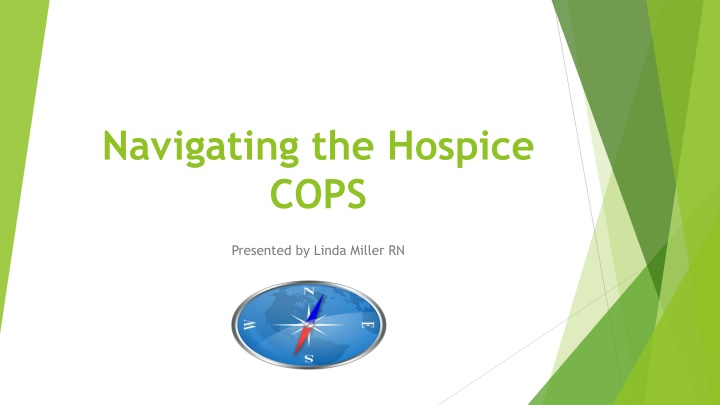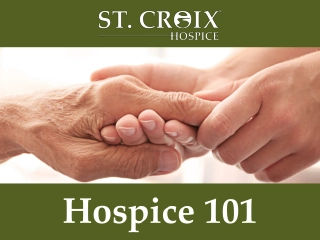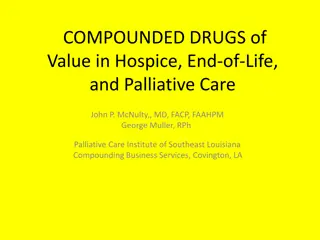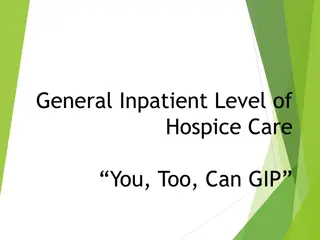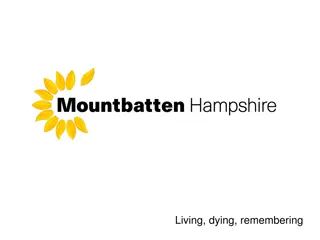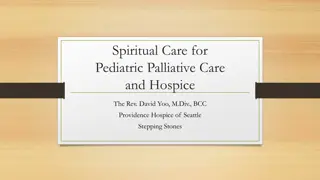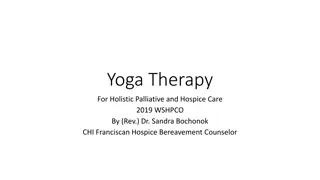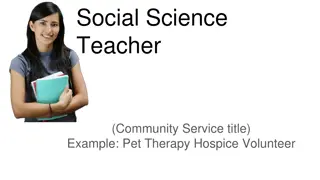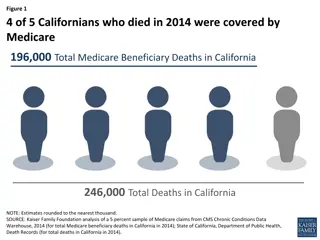Navigating the Hospice
The Hospice Conditions of Participation (COPS) set health and safety requirements for hospices, ensuring quality improvement in care. Explore the essential elements such as General Provisions, Patient Care Services, Organizational Environment, Covered Services, Payment, and more. Gain insights into the statutory basis and definitions crucial for hospice programs participating in the Medicare program.
Download Presentation

Please find below an Image/Link to download the presentation.
The content on the website is provided AS IS for your information and personal use only. It may not be sold, licensed, or shared on other websites without obtaining consent from the author.If you encounter any issues during the download, it is possible that the publisher has removed the file from their server.
You are allowed to download the files provided on this website for personal or commercial use, subject to the condition that they are used lawfully. All files are the property of their respective owners.
The content on the website is provided AS IS for your information and personal use only. It may not be sold, licensed, or shared on other websites without obtaining consent from the author.
E N D
Presentation Transcript
Navigating the Hospice COPS Presented by Linda Miller RN
What are the Hospice COPS? The COPS(Hospice Conditions of Participation) are the health and safety requirements that all hospices are required to meet. They are a flexible framework for continuous quality improvement in hospice care and reflect current standards of practice.
Conditions Of Participation Subpart A- General Provision and Definitions Subpart B- Eligibility, Election and Duration of Benefits Subpart C- Condition of Participation-Patient Care Core Services and Non- Core Services Subpart D- Conditions of Participation: Organizational Environment Subpart E-Conditions of Participation: Removed and Reserved Subpart F- Covered Services Subpart G- Payment for Hospice Care Subpart H- Coinsurance
Subpart A-General Provisions and Definitions 418.1- Statutory Basis- This outlines specific services that a hospice program must meet in order to participate in the Medicare program. 418.3- Definitions Attending physician means a (i) Doctor of medicine or osteopathy legally authorized to practice medicine and surgery by the State in which he or she performs that function or action; OR (ii) Nurse practitioner who meets the training, education, and experience requirements as described in 410.75 (b) of this chapter. As of 2019, PA s can be an attending. (2) Is identified by the individual, at the time he or she elects to receive hospice care, as having the most significant role in the determination and delivery of the individual s medical care.
Subpart A Bereavement counseling means emotional, psychosocial, and spiritual support and services provided before and after the death of the patient to assist with issues related to grief loss and adjustment. Comprehensive assessment means a thorough evaluation of the patient s physical, psychosocial, emotional and spiritual status related to the terminal illness and related conditions. This includes a thorough evaluation of the caregiver s and family s willingness and capability to care for the patient. Dietary counseling means education and interventions provided to the patient and family regarding appropriate nutritional intake as the patient s condition progresses. Dietary counseling is provided by qualified individuals, which may include a registered nurse, dietitian or nutritionist, when identified in the patient s plan of care.
Subpart A Employee means a person who: (1) Works for the hospice and for whom the hospice is required to issue a W 2 form on his or her behalf; (2) if the hospice is a subdivision of an agency or organization, an employee of the agency or organization who is assigned to the hospice; or (3) is a volunteer under the jurisdiction of the hospice. Hospice care means a comprehensive set of services described in 1861(dd)(1) of the Act, identified and coordinated by an interdisciplinary group to provide for the physical, psychosocial, spiritual, and emotional needs of a terminally ill patient and/or family members, as delineated in a specific patient plan of care.
Subpart A Initial assessment means an evaluation of the patient s physical, psychosocial and emotional status related to the terminal illness and related conditions to determine the patient s immediate care and support needs. Representative means an individual who has the authority under State law (whether by statute or pursuant to an appointment by the courts of the State) to authorize or terminate medical care or to elect or revoke the election of hospice care on behalf of a terminally ill patient who is mentally or physically incapacitated. This may include a legal guardian. Terminally ill means that the individual has a medical prognosis that his or her life expectancy is 6 months or less if the illness runs its normal course.
Subpart B-Eligibility, Election and Duration of Benefits 418.20 Eligibility requirements. In order to be eligible to elect hospice care under Medicare, an individual must be: (a) Entitled to Part A of Medicare; and (b) Certified as being terminally ill with 6 month prognosis. 418.21 Duration of hospice care coverage Election periods. (a) Subject to the conditions set forth in this part, an individual may elect to receive hospice care during one or more of the following election periods: (1) An initial 90-day period; (2) A subsequent 90-day period; or (3) An unlimited number of subsequent 60-day periods.
Subpart B 418.22 Certification of terminal illness. Timing of certification (1) General rule: The hospice must obtain written certification of terminal illness for each of the periods listed even if a single election continues in effect for an unlimited number of periods. (2) Basic requirement: The hospice must obtain the written certification before it submits a claim for payment. (3) Exceptions: (i) If the hospice cannot obtain the written certification within 2 calendar days, after a period begins, it must obtain an oral certification within 2 calendar days and the written certification before it submits a claim for payment. (ii) Certifications may be completed no more than 15 calendar days prior to the effective date of election. (iii) Recertifications may be completed no more than 15 calendar days prior to the start of the subsequent benefit period.
Subpart B Face-to-face encounter- hospice physician or hospice nurse practitioner must have a face-to-face encounter with each hospice patient whose total stay across all hospices is anticipated to reach the 3rd benefit period. The face-to-face encounter must occur prior to, but no more than 30 days prior to, the 3rd benefit period recertification, and every benefit period reconciliation thereafter, to gather clinical findings to determine continued eligibility for hospice care. Content of certification includes: Prognosis of 6 months or less if illness follows its normal course. Have documentation of clinical information to support prognosis. Physician must include a brief narrative explanation that supports prognosis of 6 months or less. Attestation statement that F2F occurred and the date.
Subpart B Sources of Certification (1) For the initial 90-day period, the hospice must obtain written certification statements (and oral certification statements) by the medical director of the hospice or the physician member of the hospice interdisciplinary group; and the individual's attending physician if the individual has an attending physician. (2) For subsequent periods, the only requirement is certification by the hospice medical director or physician member of the hospice.
Subpart B 418.24 Election of Hospice Care Signed by the patient or representative. If the individual is physically or mentally incapacitated, his or her representative(HCP or legal guardian) may file the election statement. Name the hospice to provide the care Acknowledge that care is palliative and not curative Effective date of hospice care Waiver of other Medicare benefits Notice of Election(NOE)- the hospice chosen by the individual or representative must file the NOE. Must file within 5 calendar days after the effective date of the election statement.
Subpart B When a hospice does not file the NOE in 5 days, Medicare will not cover and pay for the days of hospice care from the date of the election to filing of NOE. Exceptions to not filing NOE: Fires, floods, earthquakes or unusual events that inflict extensive damage to the hospice s ability to operate. A CMS or Medicare systems issue A newly certified Medicare hospice program that is awaiting a user ID.
Subpart B Content of Election Statement The election statement must include the following: (1) Identification of the particular hospice and of the attending physician that will provide care to the individual. The individual or representative must acknowledge that the identified attending physician was his or her choice. (2) Identification of the particular hospice that will provide care to the individual. (3) The individual's or representative's acknowledgement that he or she has been given a full understanding of the palliative rather than curative nature of hospice care, as it relates to the individual's terminal illness. (4) Acknowledgement that certain Medicare services, are waived by the election. (5) The effective date of the election, which may be the first day of hospice care or a later date, but may be no earlier than the date of the election statement. (6) The signature of the individual or representative.
Subpart B Changing the attending Physician-To change the designated attending physician, the individual (or representative) must file a signed statement with the hospice that states that he or she is changing his or her attending physician. (1) The statement must identify the new attending physician, and include the date the change is to be effective and the date signed by the individual (or representative). (2) The individual (or representative) must acknowledge that the change in the attending physician is due to his or her choice. (3) The effective date of the change in attending physician cannot be before the date the statement is signed.
Subpart B 418.25 Admission to hospice care (a) The hospice admits a patient only on the recommendation of the medical director in consultation with, or with input from, the patient s attending physician (if any). (b) In reaching a decision to certify that the patient is terminally ill, the hospice medical director must consider at least the following information: 1) Diagnosis of the terminal condition of the patient. (2) Other health conditions, whether related or unrelated to the terminal condition. (3) Current clinically relevant information supporting all diagnoses.
Subpart B 418.26 Discharge from hospice care (a) Reasons for discharge. A hospice may discharge a patient if (1) The patient moves out of the hospice s service area or transfers to another hospice; (2) The hospice determines that the patient is no longer terminally ill; OR (3) The hospice determines, discharge for cause that meets the requirements of a behavior that is disruptive, abusive, or uncooperative to the extent that delivery of care to the patient or the ability of the hospice to operate effectively is seriously impaired. Discharge from hospice: Order from hospice medical director Discharge planning process that includes any necessary education, counseling or referrals for continued needs, and plan of care. Notify attending physician Discharge summary
Subpart B 418.28- Revoking the election of hospice care Patient or representative can revoke the benefit at any time. Must file signed revocation statement with the hospice that specifies the date of revocation-can be a future date but cannot back date. Verbal revocation not allowed-must be signed. May elect to receive hospice again as eligible.
Subpart B 418.30 Change of the designated hospice. (a) An individual or representative may change, once in each election period, the designation of the particular hospice from which hospice care will be received. (b) The change of the designated hospice is not a revocation of the election for the period in which it is made. (c) To change the designation of hospice programs, the individual or representative must file, with the hospice from which care has been received and with the newly designated hospice, a statement that includes the following information: (1) The name of the hospice from which the individual has received care and the name of the hospice from which he or she plans to receive care. (2) The date the change is to be effective.
Subpart C- Patient Care 418.52 Patient s Rights (a) Standard: Notice of Rights and Responsibilities Verbally and in writing In a language and manner that the patient understands During the initial assessment visit in advance of furnishing care Advance Directives Must obtain patient/representative s signature confirming receipt of copy of the notice of rights and representatives.
Subpart C 418.52- Patient s rights cont. (c) Standard: Rights of the patient Pain management and symptom control Be involved in developing plan of care Refuse care or treatment Choose attending physician Confidential clinical record/HIPAA Be free of abuse Receive information about hospice benefit Receive information about scope and limitations of hospice services When the hospice receives a report of an alleged violation of patient s rights- must investigate within 5 working days. Must be reported to state immediately.
Subpart C 418.54 Standard initial and comprehensive assessment of patient Standard: Initial assessment. Completed by the RN Must occur within 48 hours after election of hospice care This is an assessment of the patient/family immediate needs Comprehensive Assessment of patient Standard: Timeframe for completion of the comprehensive assessment. The hospice interdisciplinary group, in consultation with the individual s attending physician (if any), must complete the comprehensive assessment no later than 5 calendar days after the election of hospice care in consultation with the attending physician.
Subpart C 418.54 -Standard: Content of the comprehensive assessment. The comprehensive assessment must identify the physical, psychosocial, emotional, and spiritual needs related to the terminal illness that must be addressed in order to promote the hospice patient s well-being, comfort, and dignity throughout the dying process. The comprehensive assessment must take into consideration the following factors: Physical, psychosocial, emotional and spiritual needs related to the terminal illness and related conditions. Nature and condition causing admission Complications and risk factors Functional status Imminence of death Symptom severity Drug profile Bereavement Referrals
Subpart C 418.54- standard update of the comprehensive assessment of the patient Updated by the IDG As frequently as the patient s condition requires At a minimum every 15 days Update those sections of the comprehensive assessment that require updating Patient condition change-comprehensive assessment must be updated to reflect changes
Subpart C 418.54-Standard: Patient outcome measures Patient level data elements must be included in each patient assessment Data elements must be used in patient care planning and evaluation and in the hospice s QAPI program. Data elements must be collected and documented in a consistent, systematic retrievable way.
Subpart C 418.56- Interdisciplinary group, care planning, and coordination of services. Standard: Approach to service delivery Hospice designates an IDG Hospice designates an IDG RN to provide program coordination, ensure continuous assessment of each patient s and family s needs, and ensure the implementation and revision of the plan of care The interdisciplinary group must include, but is not limited to, individuals who are qualified and competent to practice in the following professional roles: (i) A doctor of medicine or osteopathy (who is an employee or under contract with the hospice). (ii) A registered nurse. (iii) A social worker. (iv) A pastoral or other counselor.
Subpart C 418.56-Plan of care The plan of care is one of the most important documents of hospice care. IDG consults with the following to establish the plan of care -attending physician -patient or representative -Primary caregiver All services must follow a written plan of care Reflects patient and family goals Includes interventions for problems identified throughout the assessment process. Includes all services necessary for palliation and management of terminal illness and related conditions Plan of care must be reviewed as frequently as the patient s condition requires, but no less frequently than every 15 calendar days.
Subpart C 418.58- Quality assessment and performance Improvement The QAPI program: The hospice s performance improvement activities must: Focus on high risk, high volume, problem prone areas Consider severity of problems in those areas Track adverse events Data Driven Take action aimed at performance improvement Measure success of action The governing body is responsible for ensuring ongoing quality program
Subpart C 418.60-Infection Control The hospice must maintain an effective infection control program that protects patients, families, visitors, and hospice personnel by preventing and controlling infections and communicable diseases.
Subpart C 418.64- Core Services Core Services are: Nursing services Medical social services Counseling services(bereavement, dietary and spiritual)- Make bereavement services available to the family and other individuals in the bereavement plan of care up to 1 year following the death of the patient. Bereavement counseling also extends to residents of a SNF/NF or ICF/IID when appropriate and identified in the bereavement plan of care. Physical therapy services, occupational therapy services, and speech-language pathology services must be available, and when provided, offered in a manner consistent with accepted standards of practice. Only if the hospice is in a non urban area- can apply for a waiver. Physician services(directly or by contract)
Subpart C 418.76- Hospice Aide Services Hospice aide qualifications: Completed hospice aide training and competency evaluation or nurse aide training and competency evaluation or state licensure program. Written patient care instructions for a hospice aide must be prepared by a registered nurse. The aide must be oriented to the plan of care prior to seeing the patient. If no care plan present, the aide can not perform care and must contact nurse/supervisor. Supervision of Hospice Aide: RN onsite visit every 14 days to assess the hospice aide(hospice aide does not have to be present during this visit) If concerns related to care and services provided by the hospice aide are noted by the supervising RN, the hospice must make an on-site visit to the location where the patient receives care If concerns are verified the aide must complete a competency evaluation The RN must make an annual onsite visit to observe and assess each aide while performing care.
Subpart C 418.78-Volunteers Training must occur with all new volunteers Used in day-to-day administrative and/or direct patient care roles Must document ongoing efforts to recruit and retain volunteers Must document cost savings through use of volunteers Volunteers provide day-to-day administrative and direct patient care services in an amount that, at a minimum, equals to 5% of the total patient care hours of all paid and contract staff. Hospice may count volunteer driving hours in the 5% calculation as long as they count staff driving hours.
Subpart D- Organizational Environment 418.102- Medical Director Hospice designates a Medical Director. If Medical Director is not available, a designee will assume responsibilities and obligations as the Medical Director Hospice may contract with a self employed physician, physician employed by a professional entity or physician group. Medical Director is responsible for initially certifying the terminal illness, recertifying the terminal illness. Medical Director is responsible for entire medical component of the hospice s patient care program.
Subpart D 418.104 Clinical Records Content: Initial plan of care, updated plan of care, initial/comprehensive/updated assessments, clinical notes Signed notice of patient rights and election statement Responses to medications, symptom management, treatments and services Outcome measure data elements(from assessments) Physician certification and recertification Advance directives Physician orders
Subpart D Clinical Records cont. Entries must be clear, complete, legible, authenticated and dated in accordance with hospice policy and current standards of practice Follow HIPAA regulations Retention of records is 6 years after death or discharge unless state law says longer If the hospice discontinues operation, it must still comply and notify state agency and CMS Regional Office of where records are stored. Upon discharge, hospice is responsible to forward discharge summary and perhaps other data if requested.
Subpart D 418.108 Short-term Inpatient Care Provided in a Medicare certified facility Standard: Inpatient care for respite purposes- The facility providing respite care must provide 24-hour nursing services that meet the nursing needs of all patients and are furnished in accordance with each patient s plan of care. Standard: Inpatient care provided under arrangements Hospice provides POC and specify services to be furnished Hospice will train facility personnel providing care(including description of training and name of trainer) Hospice has a method for verifying this requirement Facility will provide POC, P/P with hospice, individual responsible for implementation of the agreement to the facility
Subpart D 418.110 Hospices that provide inpatient care directly Standard: Staffing 24 hour nursing services to meet patient needs Each shift must include a RN who provides direct patient care for GIP Standard: Physical environment Maintain a safe environment Written disaster preparedness plan There will be a procedure for waste, light, temp, ventilation, gas and water. Patient areas will be home-like, private for family s accommodations allowing visitors at any hour
Subpart D 418.110- Hospices that Provide Inpatient Care Directly cont. Standard: Patient rooms No more than 2 patients per room, but provide single if possible. All patients have the right to be free of restraint or seclusion imposed as a means of coercion, discipline, convenience, or retaliation. Restraints will only be imposed to ensure safety of patient, staff, or others when less restrictive interventions have not succeeded and should be discontinued at the earliest possible time. The restraint must be in accordance with a modification to the patient s plan of care and a physician s order(NP standing orders or prn)
Subpart D 418.112- Hospice Care in the LTCF A signed written agreement specifying: Communication and coordination of plan of care Hospice responsibility for determining hospice care provided Facility responsibility for 24 hour room and board, meeting patient needs as the primary giver Hospice responsibility to provide services to same extent as serving a patient in a private home. Delineation of hospice responsibilities Facility personnel to assist in the plan of care only to the extent that a hospice would routinely use a patient s family Hospice reports to facility all patient rights violations Bereavement services is provided to SNF staff Hospice will provide orientation to the hospice services staff Hospice designates IDG member to coordinate implementation of plan of care with facility representatives Provide specific documentation to the facility.
Subpart D 418.114- Personnel Qualifications All hospice professionals must be legally authorized to practice in their state of employment They must only act within their scope and keep their qualifications current at all times MSW with a graduate degree, or MSW must have 1 year experience, or bachelors in social work, psychology or other related field and 1 year experience and supervised by MSW,or Baccalaureate degree in social work and employed by hospice before 12/8/2008, and does not have to be supervised by an MSW. Criminal background checks will be performed on all employees with direct patient contact or access to patient records(hospice staff and contracted staff) Hospice contracts must require contracted entities to obtain employee background checks
Subpart D 418.116-Laws related to Health and Safety of Patients Hospice must be in compliance with all laws and regulations, and be licensed, if required by State. Hospice must disclose ownership Hospices must be approved by Medicare and licensed by the state Any lab testing(self or contracted) must be in accordance with CLIA requirements
Subpart F 418.200- Covered Services Requirements for coverage Reasonable and necessary for palliation and management of terminal illness Patient must elect hospice care Plan of care must be established by IDT prior to providing care Certification of terminal illness must be completed
Subpart F 418.202-Covered Services Nursing care Medical social services Physician services Counseling services Short term inpatient care Hospice aide and homemaker services Medical supplies and drugs related to the terminal illness and contributing to the overall prognosis of the patient Physical, speech and occupational therapy
Subpart F 418.204-Special coverage requirements Continuous care - Nursing care may be covered on a continuous basis for as much as 24 hours a day during periods of crisis as necessary to maintain an individual at home. The hospice payment on a continuous care day varies depending on the number of hours of continuous services provided. The continuous home care rate is divided by 24 to yield an hourly rate. The number of hours of continuous care provided during a continuous home care day is then multiplied by the hourly rate to yield the continuous home care payment for that day. A minimum of 8 hours of care must be furnished on a particular day to qualify for the continuous home care rate. 51%- provided by LPN or RN, 49% can be an aide. Billed midnight to midnight.
Subpart F 418.204- Special coverage requirements cont. Respite Care: (1) Respite care is short-term inpatient care provided to the individual only when necessary to relieve the family members or other persons caring for the individual. (2) Respite care may be provided only on an occasional basis and may not be reimbursed for more than five consecutive days at a time. Bereavement Counseling: required hospice service
Subpart G 418.301 Payment for Hospice Care -Basic Rules Medicare sets the payment rates Limited to a cap amount- average annual payment per patient a hospice can receive Hospices may not charge the patient for services which the patient is entitled to have payment under Medicare.
Subpart G 418.302- Payment procedures for hospice care Daily rate set by CMS 4 categories Routine Continuous care General inpatient care Inpatient respite care Payment for hospice care The intermediary reimburses hospice at the appropriate payment amount for each day the beneficiary is eligible for hospice services. Payment for 1 category per day Continuous care is paid in hourly rate and must have received at least 8 hours of care a day. Inpatient rates are based on the location the service was provided.
Subpart G 418.304-Payment for physicians services Included in hospice rate for supervisory services and participation in establishing and revising the plan of care Attending physician services that are not hospice services are not part of the hospice payment.
Subpart H 418.402- individual liability for services that are not considered hospice care. The individual is liable for the Medicare deductibles and coinsurance payments and for the difference between the reasonable and actual charge on unassigned claims on other covered services that are not considered hospice care. Examples of services not considered hospice care include: Services furnished before or after a hospice election period; services of the individual's attending physician, if the attending physician is not an employee of or working under an arrangement with the hospice; or Medicare services received for the treatment of an illness or injury not related to the individual's terminal condition.
